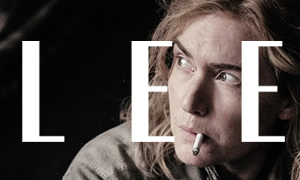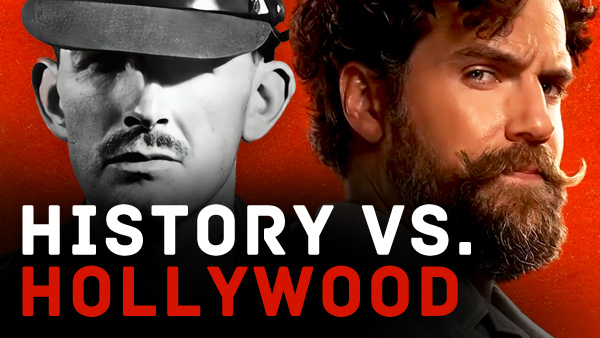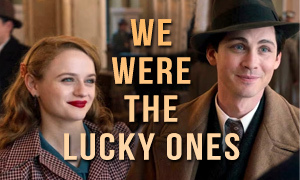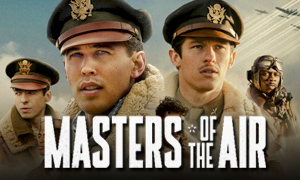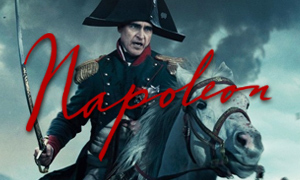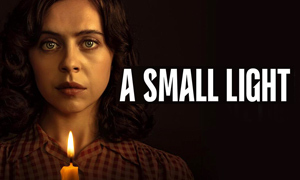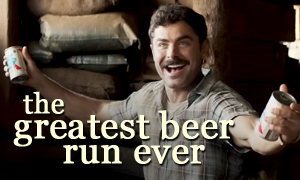Outlaw King: History vs. Hollywood
| REEL FACE: | REAL FACE: |
Chris Pine
Born: August 26, 1980 Birthplace: Los Angeles, California, USA | Robert the Bruce
Born: July 11, 1274 Birthplace: Turnberry Castle, Ayrshire, Scotland Death: June 7, 1329, Dunbartonshire, Scotland (unconfirmed illness) Image: Face Digitally Rendered from Skull |
Stephen Dillane
Born: March 27, 1957 Birthplace: London, England, UK | King Edward I of England
Born: June 17/18, 1239 Birthplace: Palace of Westminster, London Death: July 7, 1307, Cumberland, England (dysentery) Image: Portrait in Westminster Abbey |
Billy Howle
Born: November 9, 1989 Birthplace: Stoke-on-Trent, Staffordshire, England, UK | Edward, Prince of Wales (later King Edward II)
Born: April 25, 1284 Birthplace: Caernarfon Castle, Gwynedd, Wales Death: September 21, 1327, Berkeley Castle, UK (likely killed by new regime) |
Does Chris Pine resemble the real Robert the Bruce?
No. While researching the Outlaw King true story, we learned that the tomb of Robert the Bruce (1274-1329) was discovered when part of the Abbey Church in Dunfermline, Scotland was being rebuilt in 1817. Contained inside a rotted wooden coffin was the skeleton of the King of Scots. It was encased in lead and covered by fragments of Cloth of Gold shroud. A plaster cast was taken of the skull before the remains were reburied a few months later. Some items were not reinterred, including a foot bone (metatarsal), Cloth of Gold shroud, pieces of the lead coffin, and the impressive white marble table-top tomb itself. These objects are currently part of The Hunterian collection at the University of Glasgow.
Nearly two centuries after the discovery of Robert the Bruce's skull, historians led by Dr. Martin McGregor at the University of Glasgow were able to use the cast of the skull to digitally reconstruct the face of the Scottish king. "I saw an opportunity to apply the technology to the skull held here at Glasgow, first to test the credibility of its connection to Bruce and then to try to add to our knowledge of Scotland's greatest king," McGregor said. He recruited the help of Professor Caroline Wilkinson, a craniofacial expert from John Moores University, to carry out the digital reconstruction of Robert the Bruce's face.
"Using the skull cast, we could accurately establish the muscle formation from the positions of the skull bones to determine the shape and structure of the face," stated Wilkinson. "But what the reconstruction cannot show is the color of his eyes, his skin tones and the color of his hair." The digital reconstruction revealed a large and formidable head supported by a muscular neck and a stocky body. This significantly contrasts actor Chris Pine's 6-foot tall frame in the movie. Robert the Bruce's large head indicates that he was likely very intelligent. -Daily Mail Online
Were there any paintings or sculptures made of Robert the Bruce when he was alive?
No. There are no known reliable depictions of Robert the Bruce that were created during the time period when he was alive. Also, written records of the King of Scots shed no light on his appearance. This is why the images of his face that were digitally generated from the cast of his skull have offered the first real glimpse at how the King of Scots possibly looked.
Did Robert the Bruce really pledge loyalty to King Edward I before eventually rebelling against English oppression in Scotland?
Yes. The movie begins in 1304 with Robert the Bruce (Chris Pine), his father (James Cosmo), and other Scottish nobles pledging allegiance to England's King Edward I (Stephen Dillane). A fact-check of Outlaw King reveals that this indeed happened. In 1303, Edward invaded Scotland again. By 1304, the country was under submission and all of the leading Scots surrendered to Edward in February of that year, except for William Wallace, who was in hiding. Robert the Bruce and other Scottish nobles had also previously submitted to Edward in 1302, after the English king had embarked on a military campaign through Scotland.
Was King Edward I's son, the Prince of Wales, really as sadistic as he's made out to be in the movie?
No. It's true that Edward, Prince of Wales did lead campaigns into Scotland, but there's no evidence that he was as cruel as he's portrayed to be in the movie. In fact, when he became King Edward II, he was a reluctant ruler who often delegated his duties. He was not tyrannical by nature, though he did head an oppressive regime in his later years. He was known for his generosity to his household staff and for taking the time to stop and chat with his subjects, including laborers and other lower-class workers, which drew criticism from his contemporaries.
Was Edward, the Prince of Wales gay?
Speculation around the Prince of Wales sexuality stems primarily from his relationship with one of his squires, Piers Gaveston (portrayed by Ben Clifford in the movie). The two became close companions, with Gaveston eventually being temporarily exiled by the Prince's father, King Edward I, for unknown reasons. Historians have engaged in extensive debate regarding the exact nature of the Prince's bond with Gaveston, with most modern historians believing that it was more than friendship. In fictional depictions, including literature, theater and movies, the two men are almost always portrayed as lovers. This includes Braveheart, which finds Gaveston (renamed Phillip) being throne out of a window by the King (it never happened in real life). Outlaw King never directly addresses the Prince's sexuality.
In exploring the Outlaw King true story, we discovered that there is no reliable evidence to say that Edward, the Prince of Wales was definitely gay. If anything, he was more likely bisexual, since both he and Piers Gaveston had sexual relationships with their wives and they both had children. In addition, Edward was the father to an illegitimate son and possibly had an affair with Eleanor de Clare, his niece. Historians who don't necessarily believe that the Prince's relationship with Gaveston was sexual in nature cite that some such allegations were politically motivated, reasoning that it's certainly possible that the Prince and Gaveston were simply close friends who worked together.
Does the film get the costumes right?
Yes. The first thing that the movie gets right costume-wise is that there are no kilts, a possibly intentional mistake that other films like Braveheart have made. Kilts didn't become a mainstream clothing item until the 1600s. The armor that the soldiers wear is spot on for the 1300s, including the basic metal helmet, chain mail, and cuir bouilli (boiled leather armor) overtop. This is still before the era of full-plate armor.
How much crossover is there between Outlaw King and the events in Braveheart?
William Wallace was executed in London on August 23, 1305 for his disloyalty to the crown. At the start of Outlaw King, Wallace is in hiding. We then see only a glimpse of him after his execution. His face is not shown, just one arm and a portion of his chest. His presence is a reminder of what can happen for standing up to England and helps us to understand that a similar fate could be waiting for Robert the Bruce. Wallace's death also signifies a passing of the mantle of rebellion to Bruce, who will soon become King of Scots and lead them in battle against King Edward I and the English.
Wallace's grisly end was even more violent in real life. He was stripped naked and dragged by horse through the streets of London to the Elms at Smithfield. He was hanged (but released before strangulation), drawn and quartered, emasculated, eviscerated, and his bowels were burned within his sight. Finally, he was beheaded and cut into four parts. His head was stuck on a pike atop London Bridge. His limbs were sent to four northern cities, Stirling, Perth, Berwick and Newcastle, as a warning to Scots.
How much younger was Robert the Bruce's second wife, Elizabeth de Burgh?
The real Elizabeth de Burgh, King Edward I's goddaughter, was born around 1284, making her roughly 10 years younger than her husband Robert the Bruce. In the movie, Elizabeth is played by actress Florence Pugh, who is more than 15 years younger than actor Chris Pine. The real Robert the Bruce and Elizabeth de Burgh married in 1302 when Elizabeth was about 18 and Robert 28.
Did Robert the Bruce really stab and kill John Comyn, his rival for the Scottish throne?
Yes. Like in the movie, John Comyn reportedly betrayed an agreement he had made with Robert the Bruce, whereby Comyn would forfeit his claim to the Scottish throne in exchange for the Bruce lands in Scotland should Bruce start a rebellion against England. When Robert the Bruce found out that Comyn had betrayed him to King Edward I, he arranged a meeting with Comyn for February 10, 1306 at the Chapel of Greyfriars Monastery in Dumfries. Bruce accused Comyn of treachery and a fight ensued that resulted in Bruce stabbing Comyn before the high altar. English historical records of the stabbing tell a somewhat different story, stating that Bruce intended to kill Comyn all along so that he could gain the Scottish throne. The exact details of their discussion at the meeting are unclear. It's true that Bruce received absolution for his sins from the Bishop of Glasgow.
Did King Edward I's giant trebuchet really exist?
Yes. The Outlaw King true story confirms that Edward Longshanks employed a very large trebuchet during his Scottish campaign. It's possibly the largest trebuchet ever built. It even had a name, Warwolf, which we hear Edward calling it in the movie. It's featured in its historic location. It took three months to build, and like in the film, Edward wouldn't let his enemy surrender until he got to fire it at them.
Are Robert the Bruce's sidekicks in the movie based on real Scots?
Yes. During our Outlaw King fact-check, we learned that Aonghus Óg Mac Domhnaill (Tony Curran) and James Douglas (Aaron Taylor-Johnson) are real-life Scots who fought with Robert the Bruce. Aonghus Óg is believed to have switched his allegiance to King Robert I of Scotland shortly after Robert murdered John Comyn III in 1306 and crowned himself King of Scotland. Aonghus Óg and Robert fought alongside each other in Robert's greatest victory over the English, the Battle of Bannockburn.
As for actor Aaron Taylor-Johnson's character, James Douglas, Lord of Douglas, he's a real-life Scottish knight who first met King Robert I when the newly crowned King was on his way to Glasgow. This unfolds in a similar manner in the movie. The real James Douglas fought with Robert in his early defeats at Methven and the Battle of Dalrigh, and together, they learned the value of guerrilla warfare. This led to victories, including at the decisive Battle of Bannockburn in 1314. As for the battle scenes where we see James Douglas in a violent rage, that type of behavior was taken from historical accounts of his fighting style. He indeed became known as the "Black Douglas".
Did James Douglas retake his family's castle?
Yes. As seen in the movie, James Douglas went to King Edward I and asked for his family's land back, including Douglas Castle, a request that the King firmly denied. In response, Douglas and a small band of men attacked the English garrison at Douglas Castle on Psalm Sunday 1307. They were hidden until the garrison left their posts to attend the local church. Like in the film, Douglas entered the church and unleashed his war-cry, "Douglas! Douglas!" as he attacked the English soldiers inside, killing some and taking others prisoner. The prisoners were taken to the castle and beheaded. The heads were then piled in the wine casks of the castle's food cellars before the cellars were set ablaze. The well water was poisoned with salt and the festering carcasses of dead horses.
Was Robert the Bruce's second wife, Elizabeth de Burgh, really imprisoned?
Yes. In the movie, Robert the Bruce (Chris Pine) is motivated to take up arms against England after witnessing oppressive taxation, forced conscription of Scottish young men, and the imprisonment of his young new wife, Elizabeth (Florence Pugh). Robert and Elizabeth were crowned King and Queen of Scots on March 27, 1306, not long after the execution of William Wallace. After the Scots lost during a surprise night attack at the Battle of Methven on June 19, 1306, King Robert sent Elizabeth, his daughter Marjorie (from his first marriage), and his sisters to the safety of Kildrummy Castle, where Robert's brother Niall would protect them. All of this is depicted in the film.
The English laid siege to the castle and all of the men were killed, including Niall Bruce (portrayed by Lorne MacFadyen in the movie) who was drawn and quartered. The royal ladies fled and ended up in the hands of the Earl of Ross, a supporter of the Comyns who was loyal to the English throne. The ladies, including Elizabeth, were dispatched to King Edward. Elizabeth remained a prisoner of the English for eight years, held under harsh conditions of house arrest in England. She was finally returned to Scotland as part of a prisoner exchange in November 1314, 7 years after the movie’s finale at the Battle of Loudoun Hill. The film doesn't make it clear how long she was a prisoner, simply stating that she was "eventually" returned to Scotland.
Did Robert the Bruce emerge victorious at the 1307 Battle of Loudoun Hill?
Yes. Like in the Outlaw King movie, the May 1307 Battle of Loudoun Hill was the first major military victory for Robert the Bruce and his Scottish force. His rival, Aymer de Valence (played by Sam Spruell), commanded the English. De Valence had previously been victorious over an ill-prepared Robert the Bruce at the Battle of Methven the year prior, despite having not captured Bruce. Loudoun Hill, however, proved to be a sound victory for Bruce.
Was the Prince of Wales (King Edward II) let go by Robert the Bruce after being defeated at the Battle of Loudoun Hill?
No. This is pure fiction. In fact, the Prince of Wales (Edward I's son) was not even at the Battle of Loudoun Hill. He was still in the South at the time. He went north right after the battle. He disbanded the army and came back down again. It is true that his father, King Edward I, did die en route north. He developed dysentery, and as seen in the movie, his condition slowly deteriorated.
Did Robert the Bruce have leprosy?
Though the Outlaw King movie ends in the years following the 1307 Battle of Loudoun Hill, Jean Le Bel, a chronicler who lived at the time of Robert the Bruce, stated that in 1327 the king was a victim of 'la grosse maladie', which is often interpreted to mean leprosy. If he did have the disease, it was likely mild or at least hadn't affected his face very much. There is no historical record of any sort of facial disfigurement. Historians and craniofacial experts created a second version of Robert the Bruce's face (pictured below), which reveals mild signs of leprosy.
In 2017, researchers at the University of Ontario concluded that Robert the Bruce did not have leprosy, stating that both the cast of his skull and a foot bone that had not been reinterred showed no signs of the disease. Is it possible that Robert the Bruce having leprosy is a rumor that lasted for nearly seven centuries? That's what some historians now believe, pointing out that labeling someone a leper created an extremely negative stigma around that person. Attributing leprosy to Robert the Bruce could essentially have been propaganda put forth to ruin his reputation. If it was indeed a rumor, it may have been spurred on by the fact that Robert's father suffered and died from leprosy. His father's condition is more noticeable in the movie Braveheart.
Robert himself passed away a month before his 55th birthday. The cause of death remains unknown, with some speculating that it could have been cancer, heart disease, tuberculosis, syphilis, eczema, stroke, or even motor neuron disease.
